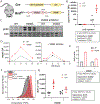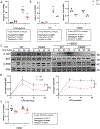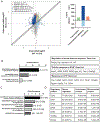BRAF-V600E utilizes posttranscriptional mechanisms to amplify LPS-induced TNFα production in dendritic cells in a mouse model of Langerhans cell histiocytosis
- PMID: 35648675
- PMCID: PMC9939017
- DOI: 10.1002/JLB.3A0122-075RR
BRAF-V600E utilizes posttranscriptional mechanisms to amplify LPS-induced TNFα production in dendritic cells in a mouse model of Langerhans cell histiocytosis
Abstract
Langerhans cell histiocytosis (LCH) is an inflammatory disease characterized by abnormal dendritic cells (DCs) with hyperactive ERK signaling, called "LCH cells." Since DCs rely on ERK signaling to produce inflammatory molecules in response to pathogenic cues, we hypothesized that hyperactive ERK enhances DCs inflammatory responses. We specifically investigated TLR4-induced TNFα production in LCH cells by utilizing the BRAF-V600Efl/+ :CD11c-Cre mouse model of LCH, which hyperactivates ERK in DCs. We measured LPS-induced TNFα production both in vivo and in vitro using splenic CD11c+ cells and bone marrow-derived DCs with or without pharmacologic BRAFV600E inhibition. We observed a reversible increase in secreted TNFα and a partially reversible increase in TNFα protein per cell, despite a decrease in TLR4 signaling and Tnfa transcripts compared with controls. We examined ERK-driven, posttranscriptional mechanisms that contribute to TNFα production and secretion using biochemical and cellular assays. We identified a reversible increase in TACE activation, the enzyme required for TNFα secretion, and most strikingly, an increase in protein translation, including TNFα. Defining the translatome through polysome-bound RNA sequencing revealed up-regulated translation of the LPS-response program. These data suggest hyperactive ERK signaling utilizes multiple posttranscriptional mechanisms to amplify inflammatory responses in DCs, advancing our understanding of LCH and basic DC biology.
Keywords: cancer; dendritic cell; herbal medicines; immunosurveillance; innate immunity; signaling; translation.
©2022 Society for Leukocyte Biology.
Conflict of interest statement
DISCLOSURE
The authors declare that there is no conflict of interest that could be perceived as prejudicing the impartiality of the research reported.
Figures





Similar articles
-
BRAF-V600E expression in precursor versus differentiated dendritic cells defines clinically distinct LCH risk groups.J Exp Med. 2014 Apr 7;211(4):669-83. doi: 10.1084/jem.20130977. Epub 2014 Mar 17. J Exp Med. 2014. PMID: 24638167 Free PMC article.
-
Langerhans cell histiocytosis: A neoplastic disorder driven by Ras-ERK pathway mutations.J Am Acad Dermatol. 2018 Mar;78(3):579-590.e4. doi: 10.1016/j.jaad.2017.09.022. Epub 2017 Oct 26. J Am Acad Dermatol. 2018. PMID: 29107340 Review.
-
Bone marrow-derived myeloid progenitors as driver mutation carriers in high- and low-risk Langerhans cell histiocytosis.Blood. 2020 Nov 5;136(19):2188-2199. doi: 10.1182/blood.2020005209. Blood. 2020. PMID: 32750121
-
RAF/MEK/extracellular signal-related kinase pathway suppresses dendritic cell migration and traps dendritic cells in Langerhans cell histiocytosis lesions.J Exp Med. 2018 Jan 2;215(1):319-336. doi: 10.1084/jem.20161881. Epub 2017 Dec 20. J Exp Med. 2018. PMID: 29263218 Free PMC article.
-
Interleukin-1 loop model for pathogenesis of Langerhans cell histiocytosis.Cell Commun Signal. 2015 Feb 22;13:13. doi: 10.1186/s12964-015-0092-z. Cell Commun Signal. 2015. PMID: 25889448 Free PMC article. Review.
References
-
- Favara BE, Feller AC, Pauli M, Jaffe ES, Weiss LM, Arico M, et al. Contemporary classification of histiocytic disorders. Med Pediatr Oncol. 1997;29:157–66. - PubMed
-
- van Furth R, Zanvil C. Origin and kinetics of mononuclear phagocytes. Ann N Y Acad Sci. 1976;278:161–75. - PubMed
-
- Morimoto A, Oh Y, Shioda Y, Kudo K, Imamura T. Recent advances in Langerhans cell histiocytosis. Pediatr Int. 2014;56:451–61. - PubMed
-
- Stålemark H, Laurencikas E, Karis J, Gavhed D, Fadeel B, Henter J-I. Incidence of langerhans cell histiocytosis in children: a population-based study helen. Pediatr Blood Cancer. 2008;50:1018–25. - PubMed
-
- Guyot-Goubin A, Donadieu J, Barkaoui M, Bellec S, Thomas C, Clavel J. Descriptive epidemiology of childhood langerhans cell histiocytosis in france, 2000–2004. Pediatr Blood Cancer. 2008;51:71–5. - PubMed
MeSH terms
Substances
Grants and funding
LinkOut - more resources
Full Text Sources
Molecular Biology Databases
Research Materials
Miscellaneous

